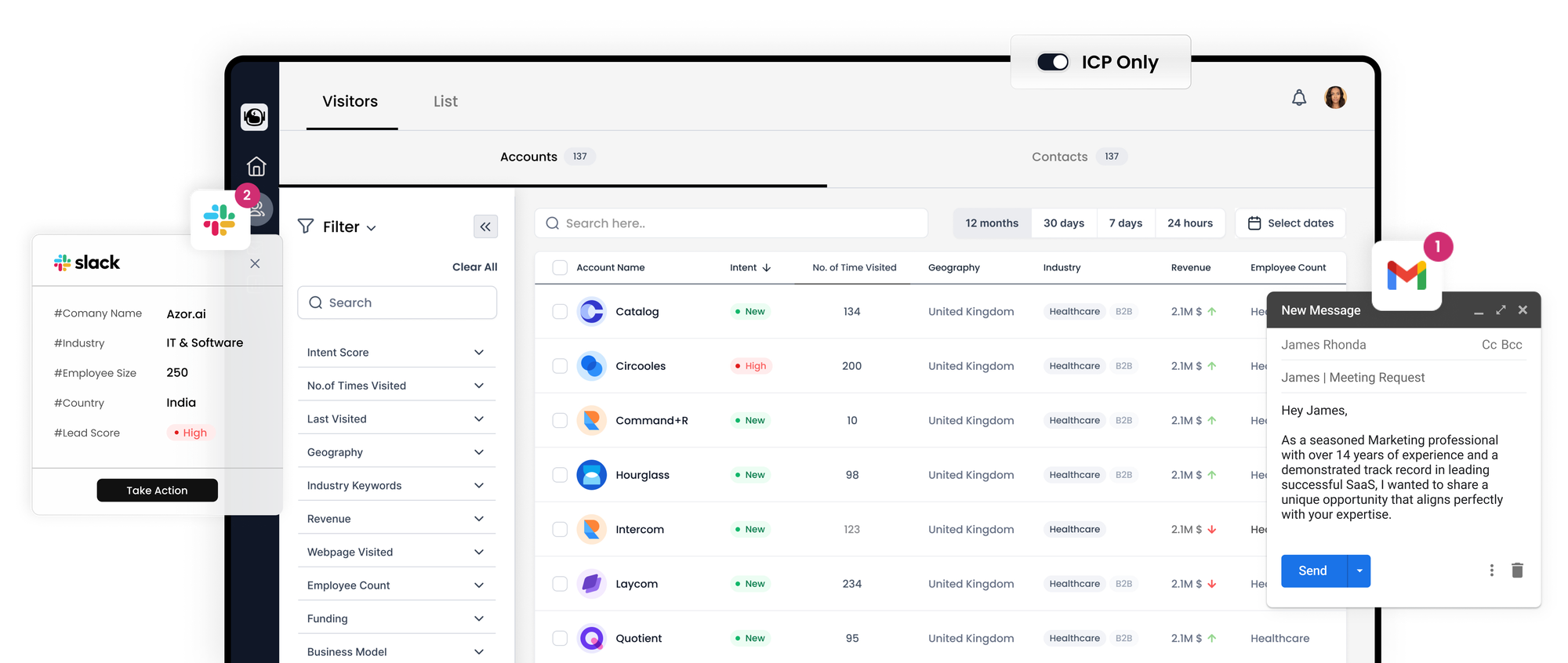Optimizing the B2B Sales Process Through Automation

In the intricate and lengthy B2B sales cycle, each moment spent on non-sales activities can be costly. To maintain a competitive edge in the B2B landscape, it's essential to streamline your sales process, and automation presents an innovative solution. It offers a strategic advantage, enabling your team to focus on critical sales and marketing initiatives rather than being bogged down by routine tasks.
In the face of fierce competition, those who don't embrace automation in their B2B sales funnel risk falling behind. If you're uncertain about how to integrate automation into your sales process, don't fret—Dealfront offers insights and guidance.
This comprehensive guide will demystify the B2B sales funnel, outline a step-by-step process for automation, recommend top-notch tools, pinpoint common pitfalls, and examine case studies of successful automation implementations.

Defining the B2B Sales Funnel
The B2B sales funnel illustrates the customer's journey from initial contact to the final purchase decision. It's a visual representation of the stages a potential buyer goes through, culminating in the acquisition of a product or service.
Key Stages of the B2B Sales Funnel
While B2B sales funnels may vary, they generally encompass these pivotal stages:
Top of the Funnel (TOFU)
The TOFU stage, also known as Awareness & Discovery, is where prospects first encounter your brand. Utilize content like blog posts, landing pages, and ads to spark interest and inform potential buyers about your existence.
Middle of the Funnel (MOFU)
In the MOFU or Evaluation stage, prospects show an active interest in your offerings. They're assessing whether you can address their specific challenges, not just whether you're a reputable vendor. Educational materials like case studies and whitepapers are key here, helping buyers conduct thorough research during their decision-making process.
Bottom of the Funnel (BOFU)
At the BOFU or Conversion stage, the prospect is ready to buy. They've vetted your solution and set a budget. Your focus should be on converting leads to customers through strategies like personalized communication, introductory offers, and compelling CTAs.
The Significance of Automation in the B2B Sales Funnel
Manual tasks can dominate the nurturing process from TOFU to BOFU, from sending follow-up emails to updating customer data. Automation steps in to handle these repetitive tasks, freeing your team to focus on direct customer engagement and strategic prospecting.
Key Advantages of Sales Funnel Automation
By automating your B2B sales funnel, you stand to gain:
Enhanced Efficiency: Automation tackles the manual, time-consuming tasks of the sales cycle, allowing you to dedicate more time to strategic lead-nurturing activities.
Elevated Productivity: With automation, your marketing efforts can become more efficient, giving you an edge in lead generation and overall productivity.
Competitive Edge: In a market where lead generation is a primary challenge for many, automation can be the difference between lagging and leading in your industry.
Whether it's improving lead nurturing or boosting overall efficiency, automation is a significant win for any B2B sales cycle. It's not just about doing more in less time—it's about doing it smarter, with an eye on growth and revenue generation.
Enhancing B2B Lead Management Through Automation
Automation not only aids in lead generation but also plays a critical role in refining lead scoring and segmentation—key elements that complement the lead generation process. Without a robust system to qualify leads, even the most prolific lead generation efforts may fall flat.
Implementing a marketing automation system that assigns scores to prospects based on their buying stage allows for an efficient ranking process. This lead scoring model assesses and prioritizes prospects by monitoring engagement levels and behaviors such as email interactions, product page visits, demo requests, free trial sign-ups, and CTA engagements.
Automatically assigning values to these actions enables you to categorize leads into segments that reflect their engagement depth, allowing for targeted marketing efforts that can significantly boost conversion rates.
Streamlining Customer Relationship Management
Today’s B2B clients anticipate personalized service. Delivering such tailored experiences necessitates a profound understanding of their business and industry, as well as fostering solid relationships with key decision-makers. Keeping up-to-date customer data is essential for crafting such personalized interactions, and this is where automation comes into play.
A sophisticated CRM system can capture and update critical data points related to your B2B clients and their companies, ensuring all communication reflects the most current information, such as any changes in job titles or roles.
Selecting Tools for B2B Marketing Funnel Automation
The range of available automation tools is vast, and it’s crucial to select those that align with your specific needs. Identify the B2B functions that would benefit most from automation and prioritize tools that are tailored to these areas.
Here’s a breakdown of top automation software and tools across various categories that can bolster your B2B marketing efforts:
CRM Systems
CRM systems are the cornerstone of B2B marketing, nurturing meaningful relationships with prospects and customers to drive loyalty and satisfaction. Automating CRM tasks like tracking customer interactions and processing service tickets can significantly enhance your success rate. Leading CRM tools include Monday Sales CRM, HubSpot CRM, Salesforce CRM, Pipedrive, and Zoho CRM.
Email Marketing Automation Tools
Given the labor-intensive nature of email marketing, it’s often one of the first functions marketers seek to automate. Numerous tools are available for this purpose, such as Mailchimp, ActiveCampaign, Customer.io, Constant Contact, Drip, and Automizy.
Social Media Management Tools
These tools keep you engaged across all your social channels, ensuring you can share updates simultaneously across different platforms. Top choices include Hootsuite, CoSchedule, Buffer, Sprout Social, and BuzzSumo.
Analytics and Reporting Tools
For data-driven decision-making, these tools are invaluable in analyzing customer data and campaign outcomes. Options like Salespanel, Tableau, Google Analytics, Adobe Analytics, and Mixpanel can offer insightful analytics.
While the ideal scenario would involve utilizing the best tool for each specific function, budget constraints might necessitate an all-encompassing tool like HubSpot or Marketo, especially if purchasing individual top-rated tools isn’t feasible.
Streamlining Your B2B Sales Funnel with Automation: A Comprehensive Guide
The complexity and length of B2B sales cycles necessitate innovative strategies for efficiency. Without a streamlined approach, you could find yourself mired in administrative tasks rather than focusing on sales—this is where automation comes in.
Embracing sales funnel automation can significantly expedite your B2B sales process, freeing up time for critical sales and marketing endeavors. In the fiercely competitive B2B market, those who don’t embrace automation risk falling behind. But fret not if you're unsure about implementation. This guide outlines a step-by-step process for automating your B2B sales funnel, complete with tool recommendations, case studies, and pitfalls to avoid.
Crafting Your Automated B2B Sales Funnel: A Step-by-Step Approach
1. Map Your Customer Journey:
Begin by defining the stages of your unique customer journey. You can draw from established models like AIDA, PAS, RaDaR, and ACID to tailor a funnel that reflects your company’s process.
2. Pinpoint Automation Opportunities:
Within each stage of your sales funnel, identify tasks ripe for automation—those repetitive and resource-heavy activities. For instance, if daily email alerts are bogging down your team, these are prime candidates for automation.
3. Select the Right Tools:
Once you’ve identified the functions to automate, find the best tools for the job. Ensure these integrate seamlessly with your existing systems to avoid costly infrastructure changes.
4. Integrate and Implement:
Carefully integrate your chosen automation tools with your IT systems. Early adoption allows you to identify and address any integration issues, ensuring a smooth operation.
5. Test, Measure, Optimize:
After a full business cycle, evaluate the effectiveness of your automation tools. Test, measure, and tweak your approach based on performance data to ensure you’re achieving optimal results.
Case Studies: Successful Automation in Action
The Expert Institute saw a 200% boost in conversions and a 60% increase in email open rates after a single email marketing automation campaign.
Brainshark, a B2B SaaS provider, utilized automation to convert freemium users to paid customers, resulting in a 15% uptick in online registrations.
CentricsIT turned to automation after manual efforts fell short, leading to a 59% increase in lead generation and $1.5 million in revenue.
Avoid These Common Automation Missteps
Preserving the Human Element
Automation should not strip the human element from your sales process. While TOFU and MOFU stages can be automated, BOFU interactions, like explainer videos, need a personal touch.
Balancing Automation
Beware of over-automating. Certain stages, like price negotiations, demand personal interaction. Automated responses can’t replicate the nuanced communication of a skilled sales representative.
Continuous Testing and Optimization
Automation isn’t a one-off setup. Regularly test and refine your tools, tracking metrics like email open rates, click-through rates, and conversion rates to ensure you’re maximizing efficiency.
Conclusion
Automation is not just a modern convenience—it’s a necessity in today’s competitive B2B landscape. By following this guide, you can effectively automate your sales funnel, giving your business the edge it needs to thrive.
